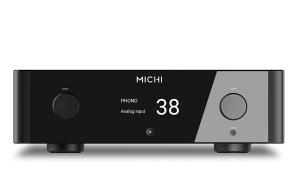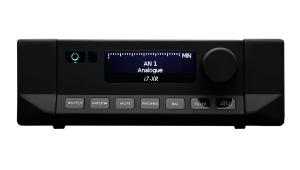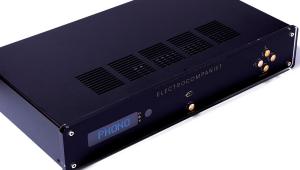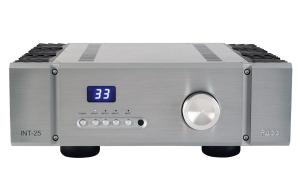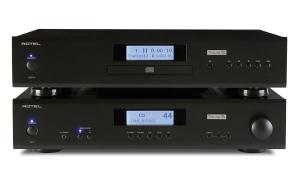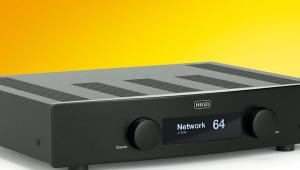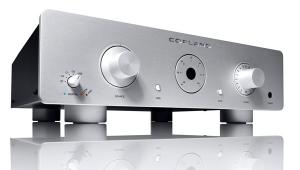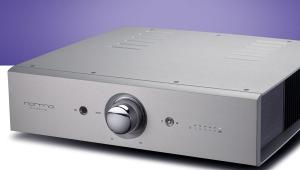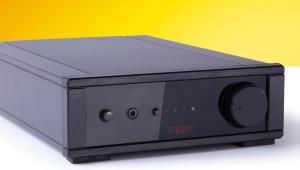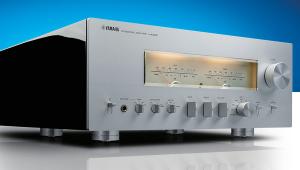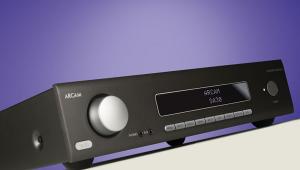VAC Sigma 170i

 If there’s one golden rule in hi-fi circles, it’s surely: ‘Always read the owner’s manual first’. For instance, you could spend ages trying to illuminate the VAC Sigma 170i’s iQ warning lights when a swift squint at the manual will let you know that in this application – the £10,000 single-chassis alternative to the company’s Signature stack – they don’t light up at switch-on. They actually only kick into action when something is amiss, so chances are you’ll never see them doing their stuff because this ‘baby’ VAC integrated never misses a beat during testing.
If there’s one golden rule in hi-fi circles, it’s surely: ‘Always read the owner’s manual first’. For instance, you could spend ages trying to illuminate the VAC Sigma 170i’s iQ warning lights when a swift squint at the manual will let you know that in this application – the £10,000 single-chassis alternative to the company’s Signature stack – they don’t light up at switch-on. They actually only kick into action when something is amiss, so chances are you’ll never see them doing their stuff because this ‘baby’ VAC integrated never misses a beat during testing.
If anything, you’ll likely spend a fair bit of time marvelling at the mix of grace and grunt, for this compact unit defies the potential of its valve complement, a ‘mere’ quartet of KT88s. Not quite a ‘beast’, perhaps, but the cautious quoted factory rating of 85W per channel is more than met. Though, let’s face it, at £10k, any amplifier should be a powerhouse, save for single-ended triodes of the sub-10W variety.
Our black-metal-flake-painted review sample (silver is also available) comes fully loaded, allowing us to exploit a couple of sources in balanced mode. The optional extras add an extra £3,700 to the price tag; they include the balanced XLR input for £800, the MM/MC £1,500 phono stage and – wholly an aesthetic choice, but worth the added peace of mind of the glassware – the cool protective glass/metal cage – a snip at £1,400.
Back to the iQ ‘Continuous Automatic Bias System’. It operates at all times, keeping an ‘i’ on the valves with one LED per tube. The lights glow green for a weak tube, red for a failed one or if it detects any potentially terminal issue, operating in advance to protect the unit. Green merely suggests you replace the valve at your convenience; red calls for turning off the Sigma 170i and replacing the duff tube when it cools down completely.
Why should this matter? Those weaned on valves during the dark old years of 1970-1985, when replacements were hard to get, will value anything that provides peace of mind. Valve aficionados circa 2021? Consider yourselves blessed, as tubes are no longer as rare as Beluga. VAC opts for octal-based KT88s, but tweakers shouldn’t be tempted to fiddle with others of that fitting. Founder and CEO Kevin Hayes explains that he chose the KT88 as a tried-and-tested tube of true merit, and he’s not one to be easily swayed by trends.
The Sigma 170i perfectly reflects its two primary virtues: convenience and compactness. Less critical for many will be the need for one less AC outlet, or one less pair of interconnects (between preamp and power amp). Space-saving alone, though, is a worthwhile reason to consider an integrated.
The Sigma 170i is less complicated to setup than its more expensive sibling, with no confusing, dedicated inputs. Blessedly, it provides multiple taps for speakers and we are able to try all three during testing, enjoying a perfect match for Falcon Acoustics’ 15ohm LS3/5A standmount, a cluster of nominally 8ohm models and the 4ohm Wilson Sasha DAW.
The back panel is self-explanatory, but note that the optional phono module takes over Input 1 – with controls fitted to the top plate rather than the front fascia. Here you’ll find toggles to select MM or MC, the latter with three possible settings of 100, 200 and 470ohm. Around the back there are also ‘cine’ throughput sockets and preamp output RCAs next to the XLR balanced inputs. The front panel, too, is self-explanatory and while the supplied remote control handset only operates mute and level via a motorised analogue pot, how often do you have two sources running concurrently?
Sound quality
Up-and-running in mere minutes, the VAC Sigma 170i – even before any lengthy warm-up – reveals itself to be a thoroughbred of classic valve sound. Hayes favours ultralinear over triode, and while hands-on perfectionists might prefer having the facility to access both, at no point do we feel the need for any added warmth or whatever else is attributed to pure triode operation.
With feeds from various open-reel tape decks, we wallow in the assorted tracks from Tchaikovsky’s Greatest Hits and even at 3¾ips, the sound is gorgeous. Though there are no artists’ credits on the compilation, via the 170i the delivery is lush and cosseting even when compared with other amps in triode mode.
Strings are extended, detailed and fast as lightning, and also utterly free of any ‘screech’ or unwanted edginess. But probably the most telling element is the sense of space and air, which remains from speaker to speaker, including the juxtaposition of changing from the big Wilsons to wee Tannoy Autograph Minis.
Moving to a more highly pedigreed tape, in that it’s twice the speed and not anonymous, the grandeur of Handel’s Messiah, with Stokowski conducting the London Symphony Orchestra and Chorus is beautifully captured and the vocal elements perfectly defined while the recreation of a concert hall defies the constraints of our listening room.
A switch to vinyl raises a thorny question, which is a subset of the integrated-vs-separates debate, and we’d be remiss not to address it. The sum of £1,500 will pay for any one of a number of astounding standalone valve phono stages, most with a far greater choice of settings, eg, models from Pro-Ject, Icon Audio, EAR-Yoshino, EAT and far too many others to list here. And who can even begin to count the exceptional solid-state phono stages, from Rega, Thorens, MoFi, ad infinitum?
And yet the entire matter of justifying an integrated phono section, encompassing convenience/space-saving/one less set of cables, as well as 100 percent compatibility cannot be ignored. It’s precisely the same rationale for buying an integrated amp per se. Luckily, VAC’s optional phono stage is exceptional.
Not that one should expect anything less from the 47kohm MM stage, which is perfectly accommodating of an Ortofon 2M Red cartridge. But what proves a blessed relief is how the three MC settings handle the TechDAS TDC01 Ti Kiseki Blue, Denon DL103GW and EAT Jo No5 (see p32) pick-ups.
A tried and true go-to bass tester, Tony Joe White’s Homemade Ice Cream, proves revelatory in the truest sense of the word, in that it exposes something previously unseen (or heard). It is to be expected that the Sasha DAW provides prodigious bass, but the VAC mates so well with it that from the opening cut, Saturday Night, In Grove, Louisiana, the experience takes on a new dimension.
Those of you who read liner notes will appreciate what it means when a band includes the cream of Nashville: the late Reggie Young on guitar, David Briggs providing piano and organ, Norbert Putnam on bass and Kenny Malone on drums. They’re among the reasons why Chad Kassem chose this LP for Acoustic Sounds’ deluxe 45rpm treatment. Any who harbour the notion that no tube amp can provide lowest-octave solidity like a transistor amp need to hear this via VAC’s 170i.
Whether it’s the bass guitar lines or the percussion work, the foundation this amplifier creates is one of weight, presence and almost-scary realism. Better still is the handling of White’s distinctive, rich, swampy vocals.
Conclusion
This prowess, however, isn’t entirely dependent on the superior pressing at higher speed. With the 2014 reissue of Etta James’ sublime Tell Mama on Bear Family, (not exactly known as a label of the audiophile tendency), the otherwise average recording does nothing to hold back one iota of James’ peerless, powerful vocals on this milestone LP.
You want emotion? Here Etta James rips out your heart, and the Sigma 170i ensures that every dynamic moment is treated with the respect it so thoroughly deserves.
With performers like this, even when recordings are not necessarily of the highest merit, the Sigma 170i does the business beautifully. Damn, this is one fine integrated. HFC
DETAILS
Product: VAC Sigma 170i
Type: Integrated amplifier
FEATURES
● Quoted power output: 2x 85W
● 4 line level inputs with an option for one to be an MM/MC phono input
● Speaker outputs for 2-4, 4-8 and 8-16ohm
● 3x 12AX7 (inc phono stage), 5x 12AU7 triodes and 4x KT88 o/p tubes
 |
Inside this month's issue:
Q Acoustics 3020c standmount loudspeakers, Perlisten R10s active subwoofer, Quad 33 and 303 pre/power amps, Acoustic Solid Vintage Full Exclusive turntable, newcomer Fell Audio Fell Amp and Fell Disc and lots, lots more...
|


